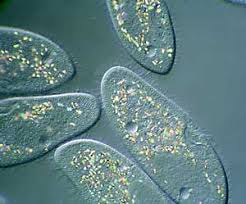Distinctive Features Of Phylum Protozoa – Zoology Notes – For W.B.C.S. Examination.
They do not have cell wall; some however, possess a flexible layer, a pellicle, or a rigid shell of inorganic materials outside the cell membrane.They have the ability during their entire life cycle or part of it to move by locomotor organelles or by a gliding mechanism.Continue Reading Distinctive Features Of Phylum Protozoa – Zoology Notes – For W.B.C.S. Examination.
Some of the characteristics are –
- There are about 50,000 known species of Phylum Protozoa.
- Protozoans exhibit mainly two forms of life; free-living (aquatic, freshwater, seawater) and parasitic (ectoparasites or endoparasites). They are also commensal in habitat.
- They are small, usually microscopic, not visualize without a microscope.
- They are the simplest and primitive of all animals.
- They have a simple body organization. i.e. with a protoplasmic grade of organization.
- The body is unicellular (without tissue and organs).
- They have one or more nuclei which are monomorphic or dimorphic.
- Body naked or bounded by a pellicle, but in some forms may be covered with shells and often provided with an internal skeleton.
- They are solitary (existing alone/single) or colonial (individuals are alike and independent).
- Body shape variables may be spherical, oval, elongated or flattened.
- Body symmetry either none or bilateral or radial or spherical.
- Body form usually constant, varied in some, while changing with environment or age in many.
- Body protoplasm is differentiated into an outer ectoplasm and inner endoplasm.
- The single-cell body performs all the essential and vital activities, which characterize the animal body; hence only subcellular physiological division of labor.
- Locomotory organs are fingers like pseudopodia, whip-like flagella, hair-like cilia or none.
- Nutrition may be holozoic (animal-like), holophytic (plant-like), saprozoic or parasitic.
- Digestion occurs intracellularly which takes place inside the food vacuoles.
- Respiration occurs by diffusion through the general body surface.
- Excretion occurs through the general body surface, but in some forms through a temporary opening in the ectoplasm or through a permanent pore called cytopyge.
- Contractile vacuoles perform osmoregulation in freshwater forms and also help in removing excretory products.
- Reproduction asexual (binary or multiple fission, budding, sporulation) or sexual (conjugation (hologamy), game formation (syngamy)).
- The life cycle often complicated with alternation of asexual and sexual phases (alternation of generation).
- Encystment commonly occurs to resist unfavorable conditions of food, temperature, and moisture, and also helps in dispersal.
- The single-celled individual not differentiated into somatoplasm and germplasm; therefore, exempt from natural death which is the price paid for the body.
- Protozoans exhibit mainly two forms of life; free-living (aquatic, freshwater, seawater) and parasitic (ectoparasites or endoparasites). They are also commensal in habitat.
- Examples: Euglena, Amoeba, Plasmodium, Paramecium, Podophyra, etc.
Phylum protozoa is a large and varied group and possess a complication in its classification.
Please subscribe here to get all future updates on this post/page/category/website


 +919674493673
+919674493673  mailus@wbcsmadeeasy.in
mailus@wbcsmadeeasy.in







































































































